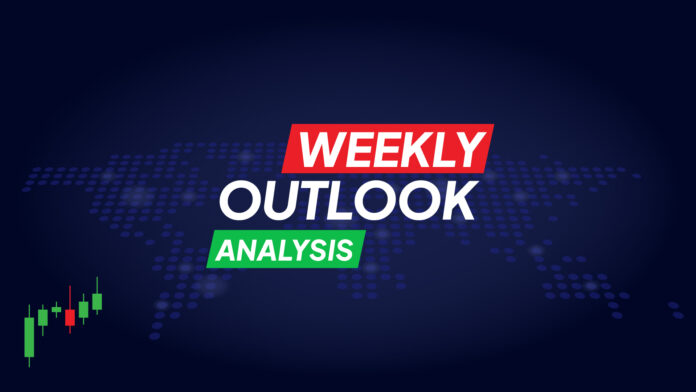The week of May 19–23 promises to be pivotal for global markets. In the U.S., investors will closely watch PMI data and speeches from key Federal Reserve officials for clues on the future path of interest rates—especially after April’s persistent inflation and the easing of recession fears following a surprising U.S.-China trade truce. Meanwhile, the Reserve Bank of Australia’s rate decision, along with economic reports from China, Canada, and Japan, will provide regional direction. In the UK, inflation and retail sales could reshape expectations for further Bank of England cuts, while eurozone PMIs will test the ECB’s cautious stance.
For additional insights into market movements, explore our educational hub at https://hub.onequity.com, where you can access updated financial data, analysis, and trading resources.
Key Points To Watch Out For:
- The bullish dollar anticipates Fed speakers and PMIs.
- The RBA will cut 25 bps, with focus on future projections.
- Prolonged inflation in the UK could signal only one more BoE rate cut.
- Eurozone PMIs and CPI data from Canada and Japan will also be published.
The Trade Agreement Between the US and China Increases Risk Appetite and Eases Recession Fears
Investor confidence improved significantly last week after the U.S. and China reached a surprisingly constructive agreement in their latest trade negotiations. The two economic giants agreed to reduce tariffs by 115% for 90 days; during this truce, China will apply a 10% tariff on U.S. products, while the U.S. will tax Chinese imports at 30%.
The agreement has significantly eased fears of an imminent recession, leading investors to lower their expectations of rate cuts by the Fed. Markets, which had priced in cuts of more than 100 basis points after Trump’s “Liberation Day,” now expect only 57 basis points—closer to the Fed’s latest forecast, which pointed to 50 basis point cuts by the end of the year.
Fed Officials and PMIs in the Spotlight After Persistent Inflation
Following April CPI data showing persistent core inflation, attention now turns to this week’s preliminary PMIs and comments from key Fed officials. With sentiment improving after the U.S.-China deal, investors are eager to assess whether the Fed remains focused on inflation or refocuses on growth concerns.
A rise in PMIs could signal improved business optimism, but markets will be looking for clearer guidance from the Fed. Speakers scheduled to speak include John Williams of the New York Fed, Raphael Bostic of Atlanta, Lorie Logan of Dallas, and Mary Daly of San Francisco. If they emphasize inflation risks, the dollar could extend its gains as markets further reduce bets on a rate cut.
Equities may not respond as clearly. While recent gains were driven by easing recession fears, the narrative of “higher for longer” rates—especially if driven by persistent inflation—could weigh on Wall Street.
RBA Decision: Less Dovish Than Markets Expect?
The Reserve Bank of Australia meets on Tuesday, its first decision since Trump’s trade truce announcement. At its last meeting, held the day before the announcement, the RBA kept rates unchanged, citing inflation as its main concern.
Since then, first-quarter inflation has proved more persistent than expected. However, global uncertainties had led markets to price in around 80 basis points of cuts this year, with a 25 basis point cut this week almost fully priced in.
However, with inflation remaining close to the upper end of the RBA’s 2–3% target range and tensions between the U.S. and China easing, policymakers may be reluctant to back such a dovish outlook. While the RBA could leave the door open for further easing, a less dovish tone could boost the Australian dollar.
Ahead of the RBA meeting, traders will be watching for April data from China, due on Monday, May 19: industrial production, fixed asset investment, and retail sales. However, given that these figures predate the tariff rollback, any market reaction is likely to be muted and short-lived.
CPI and UK Data Could Limit the Bank of England’s Rate Cut Cycle
The UK will release April CPI on Wednesday, May 21, followed by May PMIs and retail sales data. Earlier this month, the Bank of England cut rates by 25 basis points, but the decision was divided: five voted for a cut, two for 50 basis points, and two for keeping rates unchanged. Governor Andrew Bailey emphasized the need for a cautious approach given the persistent economic uncertainty, including the impact of tariffs.
Following the more aggressive-than-expected tone, investors cut their expectations for total cuts this year from 75 to 45 basis points. If this week’s data reveals persistent inflation, rising PMIs, and solid retail sales, markets could further reduce expectations for cuts—which could boost the pound sterling.
Conclusion
Eurozone PMIs are due on Thursday, May 22. The ECB, after cutting rates by 25 basis points and warning of risks to growth from tariffs, is expected to cut again in June. However, only one additional move is expected for the rest of 2025. Improving PMIs could validate recent comments from ECB member Isabel Schnabel, who said that rates should remain close to current levels—which would be supportive for the euro.
Meanwhile, Canada and Japan will release April CPI data on Tuesday, May 20, and Friday, May 23, respectively. In Canada, inflation is within the Bank of Canada’s 1–3% target, but weak labor data and rising unemployment have increased expectations of a rate cut in June. More moderate CPI data could consolidate those bets and weigh on the Canadian dollar.
In Japan, although first-quarter GDP showed a contraction, the rebound in the Tokyo CPI has raised expectations of further tightening. A solid national CPI could strengthen the case for a rate hike by the Bank of Japan at the end of the year, especially as markets are already pricing in a 70% chance of a 25 basis point hike.
Trade with confidence—get the latest market insights at OnEquity.com.



